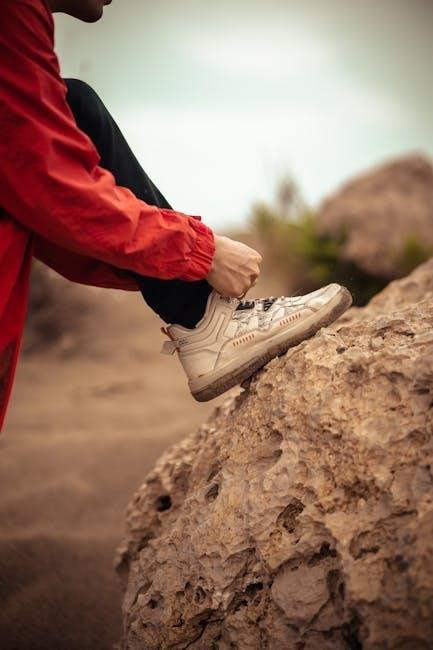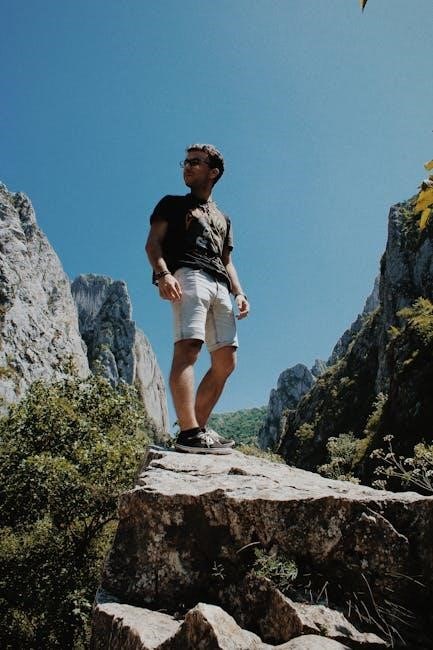
Properly fitting climbing shoes are vital for performance and comfort. Factors like brand, foot shape, and climbing discipline determine the ideal size, ensuring precision and endurance on any terrain.
Understanding the Importance of Proper Fit
A proper fit in climbing shoes is crucial for both performance and comfort. Tight shoes enhance precision and sensitivity on small holds, while loose shoes can compromise control. Overly tight footwear may cause discomfort or pain, especially during long climbs. Conversely, shoes that are too roomy can lead to poor grip and reduced accuracy. The right fit ensures optimal power transfer and stability, enabling climbers to tackle various terrains effectively. Properly fitted shoes also reduce the risk of blisters and fatigue, allowing climbers to focus on their technique and endurance. A well-fitting shoe is an essential foundation for a successful climbing experience.
Factors Influencing Climbing Shoe Size
Foot measurement, brand variations, climbing discipline, and street shoe size differences are key factors affecting climbing shoe sizing, ensuring a precise and comfortable fit for optimal performance.
Foot Measurement and Brand Variations
Accurate foot measurement is crucial for selecting the right climbing shoe size. Each brand uses a specific last, leading to variations in fit and sizing. For instance, La Sportiva shoes often run smaller than street shoes, requiring a half to full size up for comfort. Meanwhile, Black Diamond shoes may align closely with street shoe sizes but offer a snug fit. Understanding these brand-specific differences ensures a proper fit, as unlined leather shoes can stretch, while synthetic materials maintain their shape. Always refer to the brand’s size chart and consider personal comfort during the selection process.
Climbing Discipline and Shoe Type
Different climbing disciplines demand specific shoe types, influencing size choices. Bouldering and lead climbing require precise fit for performance, often needing a snugger shoe. Trad climbing may allow a slightly roomier fit for comfort during long routes. Sport climbing balances performance and comfort, while slipper shoes are ideal for indoor sessions. Each discipline’s demands shape the optimal shoe size, ensuring both power and comfort. Understanding these nuances helps climbers choose the right fit for their specific needs, enhancing overall performance and reducing discomfort during climbs.
Street Shoe Size vs. Climbing Shoe Size
Climbing shoes often run smaller than street shoes due to their snug fit requirements; Typically, climbers opt for a size 1-2 sizes smaller than their street shoes for optimal performance. This tight fit ensures better control and sensitivity on holds. However, the exact difference varies by brand and shoe type. For example, aggressive shoes may require a tighter fit, while neutral shoes might be closer to street shoe sizes. Adjusting based on brand-specific sizing charts and personal comfort ensures the right balance between performance and comfort during climbs.

Types of Climbing Shoes
Climbing shoes are categorized into neutral, moderate, and aggressive based on their downturn and asymmetry. Neutral shoes offer comfort for long climbs, while aggressive shoes prioritize precision on overhangs. Additionally, soft-soled shoes provide sensitivity, and hard-soled shoes deliver support for edging. Each type suits different climbing disciplines, ensuring climbers can match their footwear to their specific needs and terrain, enhancing both performance and comfort during their ascents.
Neutral, Moderate, and Aggressive Shoes
Climbing shoes are categorized into three main types based on their performance and comfort: neutral, moderate, and aggressive. Neutral shoes feature a flat last, offering comfort for long climbs and versatility for techniques like smearing. Moderate shoes provide a balance, with a slight downturn for edging and crack climbing. Aggressive shoes are highly downturned, maximizing precision on small holds for overhung routes. Each type suits different climbing styles, from beginner-friendly neutrality to high-performance aggression. The choice depends on the climber’s discipline, experience level, and specific needs, ensuring optimal fit and functionality for their climbing goals.
Soft vs. Hard Sole Climbing Shoes
Climbing shoes differ in sole stiffness, with soft and hard soles catering to different climbing needs. Soft-soled shoes prioritize sensitivity and flexibility, ideal for smearing and nuanced footwork on delicate terrain. They mold to small holds, offering precise feedback. In contrast, hard-soled shoes provide rigidity and support, excelling on edges and cracks where stability is key. While soft soles enhance performance in bouldering and sport climbing, hard soles are preferred for trad and multi-pitch routes. The choice depends on the climber’s discipline, technique, and the type of terrain they frequent, ensuring optimal grip and control.

How to Choose the Right Size
Measure your foot accurately, use brand-specific charts, and consider stretch. Try shoes on if possible for a snug, performance-fit that balances comfort and precision on the wall.
Measuring Your Foot Correctly
Accurate foot measurement is crucial for selecting the right climbing shoe size. Use a ruler or Brannock device to measure the length of your foot while standing straight. Ensure the measuring tool is flat and aligned with your heel. Measure both feet, as they may differ slightly, and use the larger measurement. Climbing shoes often fit tighter than street shoes, so compare your foot length to brand-specific size charts. Proper sizing ensures optimal performance, comfort, and precision on the wall, while ill-fitting shoes can hinder your climbing ability and cause discomfort during extended use.
Using Brand-Specific Size Charts

Each climbing shoe brand has its own sizing standards, so consulting their specific size charts is essential. Compare your measured foot length to the chart, noting that sizes may vary between brands. For example, La Sportiva and Black Diamond often differ slightly in their sizing. Some brands offer half sizes, while others round up or down. Ensure you account for potential stretch in leather shoes and consider the break-in period. Using brand-specific charts helps you align your foot measurements with the intended fit, ensuring accuracy and comfort. This step is critical for optimal performance and satisfaction with your climbing shoes.
Considering Stretch and Break-In Period
Different materials and constructions affect how climbing shoes fit over time. Leather shoes, especially unlined models, can stretch up to a full size, while synthetic shoes remain stable. During the break-in period, shoes may feel tight but will mold to your feet. For performance-oriented climbers, starting with a snug fit allows the shoe to adapt without compromising precision. However, over-tightening can lead to discomfort. It’s essential to balance initial tightness with expected stretch to ensure a comfortable yet precise fit during and after the break-in period, enhancing both performance and durability of the shoes.
Common Mistakes in Sizing
Ignoring brand-specific sizing charts and not considering foot shape often lead to poor fits. Over-tightening reduces circulation, while under-tightening decreases performance, affecting overall climbing efficiency and comfort.
Ignoring Brand Differences
One of the most common mistakes climbers make is not accounting for brand-specific sizing variations. Brands like La Sportiva, Black Diamond, and others use different lasts, which can result in varying fits. For example, La Sportiva shoes tend to run narrower, while Black Diamond may offer a roomier toe box. Ignoring these differences can lead to a poor fit, affecting both comfort and performance. Always consult the brand’s size chart and try shoes on if possible to ensure the best fit for your foot shape and climbing style.
Over-Tightening or Under-Tightening
Over-tightening climbing shoes can restrict blood flow and cause discomfort, while under-tightening may reduce precision on small holds. Many climbers mistakenly opt for a snug fit, believing it enhances performance, but this can lead to pain and fatigue during long climbs. Conversely, shoes that are too loose can cause foot movement, compromising control. Finding the right balance is key. Test the fit by standing and flexing your feet; your toes should gently press the front without curling painfully. Adjust laces or straps to ensure a secure yet comfortable fit for optimal performance and endurance.
Brand-Specific Sizing Tips
La Sportiva, Black Diamond, and other brands have unique sizing profiles. La Sportiva tends to run snug, while Black Diamond offers a roomier fit. Always refer to specific brand charts for accurate sizing, as differences can vary by half a size or more. This ensures the best fit and performance for your climbing needs.
La Sportiva, Black Diamond, and Other Popular Brands
La Sportiva climbing shoes are known for their snug fit, often requiring climbers to size down by half a size for optimal performance. Black Diamond shoes, conversely, tend to run slightly larger, offering a roomier toe box. Other brands like Boreal and Five Ten also have unique sizing profiles. For example, Boreal’s Fire model fits true to size, while Five Ten shoes often require sizing down due to their stretchy uppers. Always consult brand-specific size charts and try shoes on if possible, as variations in last shape and materials can significantly impact fit and comfort.

Care and Maintenance
Regularly clean your climbing shoes with mild soap and water, then air dry to prevent odor. Store them in a cool, dry place to maintain shape and durability.
How to Break In Climbing Shoes
Breaking in climbing shoes requires patience to ensure comfort and performance. Start by wearing them for short periods indoors, gradually increasing duration. For leather shoes, use shoe stretchers or stuff with paper overnight. Softening the heel and toe box can be done with gentle heat or a hairdryer. Avoid extreme methods like soaking, as this may damage materials. For synthetic shoes, break-in is minimal, but stretching the toe box can help. Always prioritize a snug fit without pain, as shoes will mold to your feet over time with use. Proper break-in enhances climbing efficiency and longevity of the shoes.
